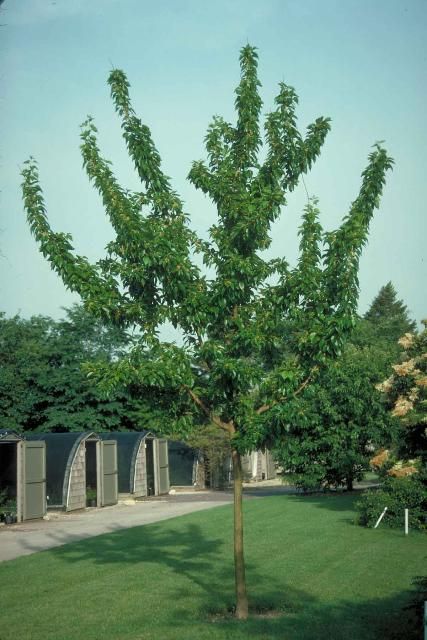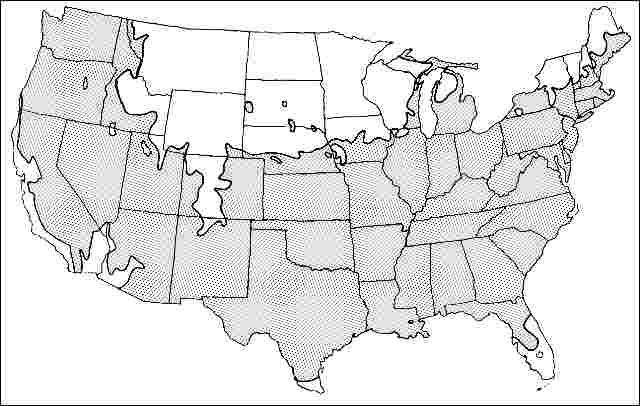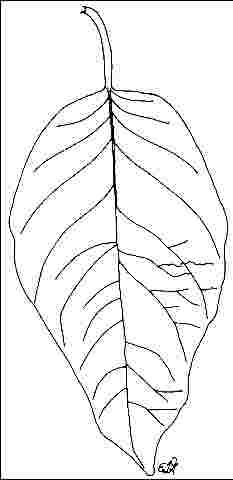Introduction
This deciduous North American native tree rapidly grows 30 to 40 feet tall with a spread of 20 to 40 feet and creates a dense canopy, making it useful as a windbreak. Young trees can develop an upright, pyramidal habit. The large, three to six-inch-long by two to three-inch-wide, shiny, dark green leaves turn bright yellow in fall before dropping, although this color change is not quite as noticeable on trees grown in the southeastern United States. The bark is deeply furrowed and has an orange tinge to it, and the strong, durable wood is bright orange in color.

Credit: Ed Gilman
General Information
Scientific name: Maclura pomifera
Pronunciation: muh-KLOO-ruh poe-MIFF-er-uh
Common name(s): Osage-Orange, Bois-D'Arc
Family: Moraceae
USDA hardiness zones: 5A through 9A (Fig. 2)
Origin: native to North America
Invasive potential: little invasive potential
Uses: reclamation; urban tolerant
Availability: somewhat available, may have to go out of the region to find the tree

Description
Height: 30 to 40 feet
Spread: 20 to 40 feet
Crown uniformity: irregular
Crown shape: spreading, round
Crown density: open
Growth rate: fast
Texture: coarse
Foliage
Leaf arrangement: alternate (Fig. 3)
Leaf type: simple
Leaf margin: entire, undulate, sinuate/undulate
Leaf shape: ovate, lanceolate, oblong
Leaf venation: pinnate
Leaf type and persistence: deciduous
Leaf blade length: 2 to 4 inches, 4 to 8 inches
Leaf color: green
Fall color: yellow
Fall characteristic: showy

Flower
Flower color: white/cream/gray
Flower characteristics: not showy
Fruit
Fruit shape: round
Fruit length: 3 to 6 inches
Fruit covering: fleshy
Fruit color: green
Fruit characteristics: attracts squirrels/mammals; showy; fruit/leaves a litter problem
Trunk and Branches
Trunk/bark/branches: branches droop; showy; typically multi-trunked; no thorns
Pruning requirement: needed for strong structure
Breakage: resistant
Current year twig color: brown
Current year twig thickness: thick
Wood specific gravity: unknown
Culture
Light requirement: full sun
Soil tolerances: clay; sand; loam; alkaline; acidic; extended flooding; well-drained
Drought tolerance: high
Aerosol salt tolerance: moderate
Other
Roots: can form large surface roots
Winter interest: no
Outstanding tree: no
Ozone sensitivity: tolerant
Verticillium wilt susceptibility: susceptible
Pest resistance: free of serious pests and diseases
Use and Management
It is reported that the Osage Indians made their hunting bows from this beautiful and hard wood, and it is also used to make furniture. From April to June, Osage-Orange puts out its inconspicuous green flowers but these are followed by the very conspicuous fruits. The fruits are four to five-inch-diameter, rough-textured, heavy green balls which ripen to yellow-green and fall in October and November. These fruits are inedible, the juice acid and milky, but squirrels relish the small seeds buried inside the pulp. When the fruits drop, they can be very messy and, for this reason, male, fruitless trees should be selected if you plant this tree. Osage-Orange is thorny, just like true citrus trees, and forms thickets if left to grow on its own. However, there are thornless cultivars available.
Osage-Orange should be grown in full sun on well-drained soil. This tough, native plant can withstand almost anything once established - heat, cold, wind, drought, poor soil, ice storms, vandalism - but appreciates regular watering when young until it is established.
Thornless, fruitless cultivars include `Witchita', `White Shield', and `Park'.
Propagation is by seed, cuttings, and root-cuttings. Young trees are easily transplanted.
Pests and Diseases
No pests or diseases are of major concern.
